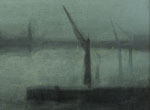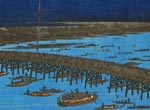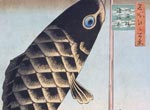
PROGRAM NOTES
Calefax Reed Quintet
Listen Now download Subscribe (itunes) Subscribe (rss) help
Program
Calefax Reed Quintet
Oliver Boekhoorn, oboe
Ivar Berix, clarinet
Raaf Hekkema, saxophones
Jelte Althuis, bass clarinet
Alban Wesly, bassoon
| Title | Time |
|---|---|
| Claude Debussy Estampes (1903) (arr. Raaf Hekkema) Pagodes (Pagodas) La soirée dans Grenade (Evening in Granada) Jardins sous la pluie (Gardens in the Rain) |
[00:00-13:53] |
| Enrique Granados Goyescas (1911) (arr. Jelte Althuis) |
[14:10-24:41] |
| Debussy Suite Bergamesque (1890; revised 1905) (arr. Oliver Boekhoorn) Menuete Clair de lune Passepied |
[24:58–40:00] |
| Johann Sebastian Bach Goldberg Variations, BWV 988 (Aria) |
[40:25-42:53] |
| Hans Abrahamsen Walden (1978) Four movements |
Bonus track |
Listen Now download Subscribe (itunes) Subscribe (rss) help
Notes
Debussy and Whistler
This concert explores relationships between visual arts and music as revealed, in part, through the work of American expatriate artist James McNeill Whistler, his influence on French composer Claude Debussy, and their mutual connection to Japan. Whistler’s work was collected often by Charles Lang Freer, founder of the Freer Gallery, and Whistler encouraged Freer to explore Asian art. The Freer Gallery now holds one of the world’s finest collections of Asian art as well as the largest collection of Whistler’s work. This year, 2012, is the 150th anniversary of Debussy’s birth, and a fitting occasion to explore his indebtedness to Whistler. (See our previous podcast of pianist Ieva Jokubaviciute for further examples of Whistler’s relationship to music.)
Whistler was one of the first artists in the West to collect and study Japanese art after Commodore Matthew Perry forcibly opened Japan to Western trade in 1854. Especially influential for Whistler (and many of the French impressionists) were Japanese woodblock prints by Katsushika Hokusai. Debussy later became familiar with the print series Thirty-six Views of Mount Fuji by Hokusai as well as One Hundred Famous Views of Edo by Utagawa Hiroshige, whose Fireworks at Ryogoku Bridge is part of the slideshow accompanying this podcast.
During the 1870s and 1880s, Whistler created a series of dark, atmospheric paintings of nighttime landscapes that he called “nocturnes.” His inspiration for these works partially came from Japanese woodblock prints. The term “nocturne” itself was suggested by Frederick Leyland, an amateur pianist and one of Whistler’s patrons. (Whistler transformed Leyland’s dining room in London into the Peacock Room, which is on permanent display in the Freer Gallery of Art.) Leyland, in turn, borrowed the label from Frédéric Chopin’s piano works of the same name, written in the 1830s.
At least three of Whistler’s nocturnes now in the Freer collection were exhibited in London in 1892, where Debussy apparently saw them. The paintings so inspired Debussy that he began composing his orchestral Nocturnes immediately upon returning to Paris, completing them from 1897 to 1899. Debussy was deeply influenced not only by Whistler’s paintings but also by his revolutionary ideas about art. Whistler’s aesthetic theories reached a wide audience in Britain through the “Ten O’Clock Lecture” he delivered in London in 1885. It was translated into French by the symbolist poet and critic Stéphane Mallarmé three years later. Both Whistler and Debussy attended a series of famous Tuesday night gatherings at Mallarmé’s Paris home, where Debussy became known as the “Whistler of music.”
Deeply influenced by Whistler’s art and thought, Debussy once described his orchestral Nocturnes as “an experiment … in finding the different combinations possible inside a single color, as a painter might make a study in gray.” The composer’s indebtedness to the visual arts is also found in the names he gave to many of his other works: images, sketches, estampes (prints), and scenes.
Like Whistler, Debussy collected Japanese art, including a lacquered wood panel titled Poisson d’Or (Goldfish). That piece inspired the last movement of his piano series Images Book II (1907), which he similarly titled Poisson d’Or. He named his 1903 piano work Estampes (Prints), which we hear in this podcast, in homage to the art of woodblock prints. For his orchestral tone-poem La Mer, Debussy insisted that his publisher place on the cover Hokusai’s famous woodcut Under the Wave off Kanagawa. The subtitle of La Mer—Three Symphonic Sketches for Orchestra—further exemplifies the importance of the visual arts to Debussy’s work.
—Michael Wilpers and Lee Glazer
Estampes
Claude Debussy (1862–1918)
Claude Debussy heard a Javanese gamelan orchestra in the Dutch pavilion at the 1889 Exposition Universelle in Paris, an experience that exerted a lasting influence on his composing. Years later this experience found its way into Pagodes, the opening movement of his Estampes. The fact that Debussy describes a Chinese temple with music inspired by Javanese sounds is immediately forgiven by the sheer beauty of the music.
Spain put the mark on the second movement: La soirée dans Grenade (Evening in Granada). Even though Debussy had never been to Spain (apart from a few hours in San Sebastián), this musical portrait of Granada could not have been more accurate. Spanish composer Manuel de Falla wrote, “There is not even one measure of this music borrowed from the Spanish folklore, and yet the entire composition in its most minute details, conveys admirably Spain.” The third movement projects the fear Debussy had felt during a midnight thunderstorm in the country. It is a horror-like synthesis between a rolling thunder and a French children’s song: “Nous n’irons plus au bois.”
Goyescas
Enrique Granados (1867–1916) (arr. Jelte Althuis)
Enrique Granados was born in Lleida, in the Catalonia region of Spain. After studies in Paris, he returned to Spain as a composer and a piano virtuoso. By that time, Spain had been defeated in the Spanish-American War, and the country had lost the last remnants of a once-grand empire. Inspired by the paintings of Francisco José de la Goya y Lucientes (1746–1828), Granados translated the essence of the Spanish soul into music in such a way that immediately after its publication in 1911, Goyescas became his most famous work.
While this cycle of six piano pieces does not refer to a specific painting by Goya, its main theme is love between young people. The Goyescas was turned into an opera that premiered in New York in 1916; Granados and his wife, Amparo, traveled to see it. Their return voyage ended tragically when their boat was struck by a German torpedo. The composer reportedly saw his wife struggling in the water, and they both drowned in his attempt to save her.
Suite Bergamasque
Claude Debussy (arr. Oliver Boekhoorn)
Debussy’s Suite Bergamasqe is one of his most fascinating works for piano, not only for its rich, impressionistic qualities but also for its somewhat mysterious creation. Supposedly Debussy began composing it in 1890, while he was still studying music. In 1905, however, he revised the works and published them under the title “Suite Bergamasque.” It is unknown how much of the work was completed in 1890 and/or 1905.
Throughout the first movement, Debussy evokes a sense of improvisation (a sound he meticulously sought while composing his work). Opening triumphantly, its playful harmonies dance along flowing lines until it finally pushes toward a climactic end similar to the opening bars. The menuete is unlike a Haydn or Mozart minuet and trio; its dancelike structure is more reminiscent of the baroque style, yet its harmonies remain true to Debussy’s impressionistic sound. The most famous of the movements, Clair de lune (Moonlight), has a sublime melody, with rivers of rolling notes, colorful harmonies, and intriguing dynamic phrases that are perhaps Debussy’s interpretation of moonlight filtering through the leaves of a tree. It is a masterpiece unto itself. The exciting final movement, with staccato in the left hand relatively throughout the movement’s entirety, is one of the most difficult to play. Its sharp contrast with flowing themes in the right hand creates a marvelous, complex sound that is a perfect ending to a beautiful suite.
Bonus
Walden
Hans Abrahamsen (b. 1952)
Written in 1978, Walden was commissioned by the Funen Wind Quintet. The title is taken from Henry David Thoreau’s novel from 1854 about the two years he spent living in the woods. His experiment was an attempt to strip away all the artificial needs imposed by society and rediscover man’s lost unity with nature.
Although Thoreau himself never completed an actual social analysis, he was way ahead of his own time in his perception of the economy and cyclic character of nature, today known as ecology. His ideas are particularly relevant now that the pollution caused by society has reached alarming proportions.
Walden was written in a style of recycling and “new simplicity.” Much superfluous material has been stripped away to reveal qualities such as identity and clarity. Various layers are encountered in the quintet, such as the organic (growth, flowering, decay), concretism (mechanical patterns), and the descriptive (distant horn calls and other ghostlike music of the past enter the consciousness like a dream). Walden consists of four movements. In 1995 another version of the reed quintet was written for the Calefax Reed Quintet.
—Hans Abrahamsen
Performers
Calefax is well known for its virtuoso performances, innovative programming, and engaging concerts. The Dutch reed quintet performs standing up and always introduces itself and the program to the audience. Most importantly, the five musicians arrange, recompose, and interpret music from eight centuries to suit their unique lineup: from early music, Renaissance, baroque, and Romantic works to jazz and world premieres.
The quintet has played more than six hundred concerts in twenty countries. It has appeared throughout Europe, both in new music forums and in early music festivals, and has toured in Sweden, Norway, Estonia, Italy, Russia, the United Kingdom, China, and the United States. Calefax received the Philip Morris Art Prize (1997), the Kersjes van de Groenekan Prize (2001), and the VSCD Classical Music Award (2005) for the best chamber music performance at Dutch venues in the 2004–2005 season. In recent years Calefax collaborated with the Zapp String Quartet, pianist Ivo Janssen, and mezzo-soprano Cora Burggraaf, among others.
The German recording label MDG issues Calefax’s ever-growing discography. The group’s latest CD features arrangements of Nancarrow’s Studies for Player Piano, described by the Dutch press as “very likely the CD of the year 2009.” Other CDs include J. S. Bach’s Goldberg Variations, Suites by Duke Ellington, and Suites by Jean-Philippe Rameau, described as “five souls playing as one.” In addition to concerts, Calefax offers master classes and workshops for young amateur musicians and conservatory students. In cooperation with the Amsterdam Concertgebouw, Calefax developed a musical game show for school children and a family concert staged by Jetse Batelaan.
Listen Now download Subscribe (itunes) Subscribe (rss) help
Related Artwork

This concert podcast explores relationships between visual arts and music, specifically the work of American expatriate artist James McNeill Whistler (1834-1903), his influence on French composer Claude Debussy (1862-1918), and their mutual connection to Japan.
During the 1870s and 80s, Whistler created a series of dark, atmospheric paintings of nighttime landscapes that he called "nocturnes," such as this one depicting the south bank of the Thames River. His inspiration for these works came, in part, from Japanese woodblock prints, while the term "nocturne" was suggested to Whistler by one of his patrons, Frederick Leyland, an amateur pianist. Leyland, in turn, borrowed the label from Frédéric Chopin's piano works of the same name, written in the 1830s. Some years later, Debussy was inspired by Whistler (rather than Chopin) when he composed orchestral works that he in turn titled "nocturnes" in the 1890s.
Nocturne: Blue and Silver—Battersea Reach; by James McNeill Whistler (American, 1834-1903); 1870-1875; oil on canvas; gift of Charles Lang Freer, F1902.97a-b

In this nocturne from the 1870s, Whistler depicts waves breaking along a beach under late evening light. All three Whistler nocturnes in this slideshow were exhibited in London in 1892, where Debussy apparently saw them. The paintings so inspired Debussy that he began composing his orchestral nocturnes immediately upon returning to Paris.
Debussy was deeply influenced not only by Whistler's paintings but also by his revolutionary ideas about art. Whistler's aesthetic theories reached a wide audience in Britain through the "Ten O'Clock Lecture" he delivered in London in 1885, which was translated into French by the symbolist poet and critic Stéphane Mallarmé in 1888. Both Whistler and Debussy attended a series of famous Tuesday-night gatherings at Mallarmé's Paris home, where Debussy became known as the "Whistler of music."
Nocturne: Blue and Silver—Bognor, by James McNeill Whistler (American, 1834-1903); 1871-1876; oil on canvas; gift of Charles Lang Freer, F1906.103a-b

This nocturne, depicting a snow-laden Trafalgar Square in Chelsea, was also in the 1892 exhibition of Whistler's work that Debussy is thought to have seen. Deeply influenced by Whistler's art and thought, Debussy once wrote about his orchestra Nocturnes (1897-99), "It's an experiment, in fact, in finding the different combinations possible inside a single color, as a painter might make a study in gray, for example." The composer's indebtedness to the visual arts is also reflected in the names he gave to many of his other works: images, sketches, estampes (prints), and scenes.
Nocturne: Trafalgar Square, Chelsea—Snow; by James McNeill Whistler (American, 1834-1903); ca. 1875-77; oil on canvas; gift of Charles Lang Freer, F1908.169a-b

Whistler was one of the first artists in the West to actively collect and study Japanese art after American Commodore Matthew Perry forcibly opened Japan to Western trade in 1854. Especially influential for Whistler (and many of the French impressionists) were Japanese woodblock prints, such as this one by the great nineteenth-century artist Utagawa Hiroshige (1797-1858). Whistler is thought to have known this image, as well as the other Japanese prints in this slideshow; they may even have formed part of his personal collection. One of his most famous nocturnes, Nocturne in Black and Gold: The Falling Rocket, portrays a nighttime scene of fireworks exploding over boats on water, very much like this print.
One Hundred Famous Views of Edo (Meisho Edo Hyakkei): Fireworks at Ryogoku Bridge (Ryo goku hanabi); by Utagawa Hiroshige (1797-1858); Japan, Edo period, 1857, eighth month; woodblock print; ink and color on paper; gift of Alan, Donald, and David Winslow from the estate of William R. Castle, F1994.30

This print by Hiroshige is another image that was probably known to Whistler and may have been in his collection. Hiroshige and his contemporary Katsushika Hokusai (1760-1849) were the Japanese artists most often collected and studied in Europe.
Like Whistler, Debussy collected Japanese art, including a lacquered wood panel titled Poisson d'Or (Goldfish). That piece inspired the last movement of his piano series Images Book II (1907), which he similarly titled Poisson d'Or. He named his 1903 piano work Estampes (prints) in direct homage to the art of woodblock prints. For his orchestral tone-poem La Mer, Debussy insisted that his publisher place Hokusai's famous woodcut The Great Wave at Kanagawa on the cover. The full title of La Mer also reflects the importance of the visual arts to Debussy's work: The Sea, Three Symphonic Sketches for Orchestra.
Suido Bridge and Surugadai, from the series One Hundred Famous Views of Edo (Edo Meisho Hyakkei); by Utagawa Hiroshige (1797-1858); Japan, Edo period, 1857, fifth lunar month; woodblock print; ink and color on paper; gift of Dr. John Fuegi, F1996.24

This is one of Thirty-six Views of Mount Fuji, by Katsushika Hokusai (1760—1849), a series that was so popular in Japan that it eventually ran to forty-six images. Whistler was introduced to the work of Hokusai in the 1850s through a copy of Hokusai's Manga, a collection of informal prints that later gave rise to the current rage in the West for Japanese comic-novels (also called manga) and animation (anime). Manga was also Debussy's introduction to Japanese prints, first shown to him in the 1880s by sculptor Camille Claudel. He later became familiar with Hokusai's Thirty-six Views of Mount Fuji and Hiroshige's Fifty-three Stations of the Tokaido.
The Sazaido Hall of the Temple, Gohyakurakanji, from the series Thirty-six Views of Mount Fuji; by Katsushika Hokusai (1760-1849); Japan, Edo period, ca. 1823-1831; woodblock print; ink and color on paper; gift of the family of Eugene and Agnes E. Meyer, F1974.63
CREDITS
Slideshow coordinated and written by Michael Wilpers, concert manager, in consultation with Lee Glazer, curator of American art. Sources: Leon Botstein, "Beyond the Illusions of Realism: Painting and Debussy's Break with Tradition," in J. F. Fulcher, ed., Debussy and His World (Princeton 2001); and Paul Roberts, Images: The Piano Music of Claude Debussy (Amadeus 1996).
Listen Now download Subscribe (itunes) Subscribe (rss) help
The Credits
Podcast, notes, and slideshow coordinated by Michael Wilpers, public programs manager. Web design by Liz Cheng and Melda Washington, audio engineering by SuMo Productions and Andy Finch, text editing by Joelle Seligson, and curatorial coordination with Lee Glazer. Special thanks to Calefax for granting permission to podcast their performance at the Freer Gallery.
Podcast Series
Concerts
Storytelling
Lectures
Subscribe to this Series
 RSS
RSS iTunes
iTunes
About Podcasts
About podcasting and how to get started
![]() Tell us what you think
Tell us what you think
Radio Asia
Explore music from all across Asia with Radio Asia, a stream of complete tracks from the collections of Smithsonian Global Sound
Most Recent Podcasts
Musicians from Marlboro IMusic of Toru Takemitsu and Tan Dun: Ralph Van Raat, piano
The Legacy of Yatsuhashi
The Traveler’s Ear: Scenes from Music
Western Music in Meiji Japan: Gilles Vonsattel, piano
Western Music in Meiji Japan
The Art of Afghan Music
Painting with Music: Bell Yung, qin
Sounds from Arabia
Tarek Yamani Trio